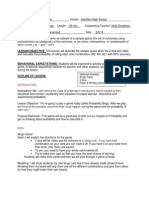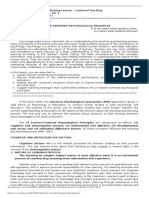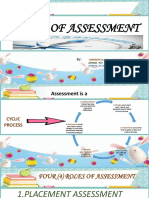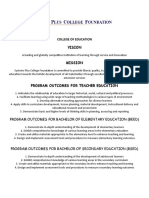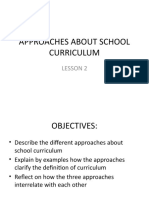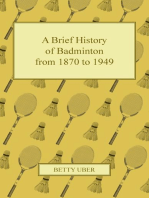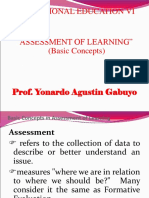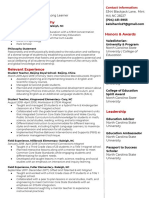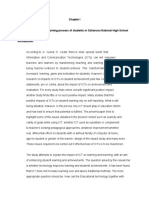Selecting and Constructing Test Items and Tasks
Selecting and Constructing Test Items and Tasks
Uploaded by
dummy langCopyright:
Available Formats
Selecting and Constructing Test Items and Tasks
Selecting and Constructing Test Items and Tasks
Uploaded by
dummy langOriginal Title
Copyright
Available Formats
Share this document
Did you find this document useful?
Is this content inappropriate?
Copyright:
Available Formats
Selecting and Constructing Test Items and Tasks
Selecting and Constructing Test Items and Tasks
Uploaded by
dummy langCopyright:
Available Formats
SELECTING AND CONSTRUCTING TEST ITEMS AND TASKS
A. Categorizing Test Types
B. Relating Test Types to Levels of Learning Outcomes
a. Measuring Knowledge and Simple Understanding
b. Measuring Deep Understanding
C. Constructing Objective Supply Type of Items
a. Completion
b. Short-answer Items
WEEK NUMBER: 10
TIME ALLOTMENT: 3 Hours
OBJECTIVES:
By the end of this module, the students shall be able to:
1. select and construct appropriate test items and tasks for classroom
assessment; and
2. apply the principles in test construction in creating test.
LEARNING CONTENT:
SELECTING AND CONSTRUCTING TEST ITEMS AND TASKS
Introduction
The previous module has familiarized you with the initial process in developing classroom
tests. True to all types of assessment tests, it always starts with a planning phase that
basically starts with the question, “What do I test?” and leads you with the preparation of a
test blueprint or a table of specifications which delineate the essential learning outcomes to
be assessed following a balanced distribution of items across the desired cognitive
behaviors. This module brings you to answer the second question, “How do I test?” This
will now introduce you to a useful menu of test types that are appropriate to gauge the
learning outcomes proposed by the curriculum standards, how to select them and how to
construct them.
Discussion
A. Categorizing Test Types The
Purpose of Testing To provide a
record for assigning grades.
To provide a learning experience for students.
To motivate students to learn.
To serve as a guide for further study.
To assess how well students are achieving the stated goals of the lesson.
To provide the instructor with an opportunity to reinforce the stated objectives and
highlight what is important for students to remember.
Characteristics of Good Tests
Validity – the extent to which the test measures what it intends to measure
Reliability – the consistency with which a test measures what it is supposed to
measure
Usability – the test can be administered with ease, clarity and uniformity
Scorability – easy to score
Interpretability – test results can be properly interpreted and is a major basis in
making sound educational decisions
Economical – the test can be reused without compromising the validity and
reliability
• Supply Type or Subjective Type of Test Items ─ this type of test requires
students to create and supply their own answer or perform a certain task to show
mastery of knowledge or skills.
• Selection Response Assessments are assessments in which students select a
response from provided alternatives. They are often referred to as objective tests, or
tests which allow for unbiased, set scoring systems.
• Performance Type - A performance test item is designed to assess the ability of a
student to perform correctly in a simulated situation (i.e., a situation in which the
student will be ultimately expected to apply his/her learning).
B. Relating Test Types to Levels of Learning Outcomes a. Measuring Knowledge
and Simple Understanding
Knowledge as it appears in cognitive taxonomies as the simplest and lowest
level, is categorized further into what thinking process is involved in learning.
Knowledge involves remembering or recalling specific facts, symbols, details,
elements of events and principles to acquire new knowledge. The revision of
Bloom’s taxonomy recognizes how remembering can be viewed not only as being
able to recall but also as being necessary in learning interrelationships among basic
elements and in learning methods, strategies and procedures. These two types of
learning make up the early phase of understanding such as remembering,
comprehending and applying. McMillan refers to the latter two as simple
understanding requiring comprehension of “concepts, ideas and generalizations”
known as declarative knowledge and application of skills and procedures learned
in new situations, referred to as procedural knowledge. They represent how
knowledge is represented in the minds of the learners either as a learned concept
or as a learned way of doing things. Table 10.1 from McMillan provides definitions
of the levels of declarative and procedural knowledge as simple understanding.
You might also like
- DLL - Bread and PastryDocument2 pagesDLL - Bread and PastryMichelle Vinoray Pascual97% (37)
- The TEACHER and THE SCHOOL CURRICULUMDocument4 pagesThe TEACHER and THE SCHOOL CURRICULUMLena DavidNo ratings yet
- Lesson 1 Probability BingoDocument4 pagesLesson 1 Probability Bingoapi-253261408No ratings yet
- Alison Fuller - Lorna Unwin - Learning As Apprentices in The Contemporary UK Workplace - Creating and ManagingDocument21 pagesAlison Fuller - Lorna Unwin - Learning As Apprentices in The Contemporary UK Workplace - Creating and ManagingMilos JankovicNo ratings yet
- Course Title Course Code Number of UnitsDocument6 pagesCourse Title Course Code Number of UnitsMingNo ratings yet
- Sarah Kirkup Cover LetterDocument1 pageSarah Kirkup Cover Letterapi-549137091No ratings yet
- CST Students with Disabilities: New York State Teacher CertificationFrom EverandCST Students with Disabilities: New York State Teacher CertificationNo ratings yet
- Module 5Document23 pagesModule 5ICS Tanauan, LeyteNo ratings yet
- Principles and Strategies of TeachingDocument11 pagesPrinciples and Strategies of TeachingKa NaNo ratings yet
- Leyte Normal UniversityDocument7 pagesLeyte Normal UniversityRosenie MalibagoNo ratings yet
- Lived Experience of Full-Time Teachers' Graduate Schooling During A PandemicDocument16 pagesLived Experience of Full-Time Teachers' Graduate Schooling During A PandemicGlobal Research and Development ServicesNo ratings yet
- Worksheet 3: Select or Deselect: Lower Left Side. While Those That Are Not On The Other BoxDocument2 pagesWorksheet 3: Select or Deselect: Lower Left Side. While Those That Are Not On The Other BoxKen AlonzoNo ratings yet
- Roles of Assessment: Cherryville T. CalixtonDocument11 pagesRoles of Assessment: Cherryville T. CalixtonWheng Adtud - MamadlaNo ratings yet
- Assessment of Learning 2, Module 5Document5 pagesAssessment of Learning 2, Module 5Rheycarl Jay Aparicio100% (1)
- The Steps of CONCEPT ATTAINMENTDocument11 pagesThe Steps of CONCEPT ATTAINMENTLahra BalanciaNo ratings yet
- Educ 2 Ind Activity No. 7 Philosophies of EducationDocument4 pagesEduc 2 Ind Activity No. 7 Philosophies of EducationAbegail Terillano InfanteNo ratings yet
- Principles 1Document37 pagesPrinciples 1Mary Cris L. ArienzaNo ratings yet
- Asl 1Document46 pagesAsl 1Divyne BonaventeNo ratings yet
- MODULE 3 AnswerDocument2 pagesMODULE 3 AnswerMichelle Gutierrez SibayanNo ratings yet
- Assessing Student Learning OutcomesDocument27 pagesAssessing Student Learning OutcomesDan DanNo ratings yet
- Chapter 3 Lesson 4 ProfEd 3Document37 pagesChapter 3 Lesson 4 ProfEd 3jasminebueno delfinNo ratings yet
- 1program Outcomes and Student Learning OutcomeDocument11 pages1program Outcomes and Student Learning OutcomeJohara Abdullah100% (1)
- Assessment of Ones Teaching PracticeDocument27 pagesAssessment of Ones Teaching PracticeMarvin CayagNo ratings yet
- Educ 106: Assessment in Learning IDocument19 pagesEduc 106: Assessment in Learning IJulie AlayonNo ratings yet
- Assessment of Learning 1Document3 pagesAssessment of Learning 1Jerson MadriagaNo ratings yet
- Characteristics of Good Learning OutcomesDocument1 pageCharacteristics of Good Learning OutcomesEstolas Shiena P.No ratings yet
- QUIZ - AffectiveDocument6 pagesQUIZ - AffectiveAnn Clarice0% (1)
- Lesson 2 - Assessment Learning 2Document20 pagesLesson 2 - Assessment Learning 2Durwin Juancho Dc DangilanNo ratings yet
- Lesson 4 Principles and Strategies in Teaching MathematicsDocument7 pagesLesson 4 Principles and Strategies in Teaching MathematicsJeorge HugnoNo ratings yet
- Classification of Test According To FormatDocument4 pagesClassification of Test According To FormatSher AwanNo ratings yet
- Educ 205 MidtermDocument10 pagesEduc 205 MidtermRichelle DadesNo ratings yet
- Assessment of Learning IDocument189 pagesAssessment of Learning Ihufana.dishelleanneNo ratings yet
- Principles of TeachingDocument3 pagesPrinciples of Teachingpaidamoyo mapangaNo ratings yet
- Field Trip (Cone of Experience)Document21 pagesField Trip (Cone of Experience)LloydDagsil100% (1)
- Assessment of Learning UpdatedDocument240 pagesAssessment of Learning UpdatedDar M GonzalesNo ratings yet
- Unit Assessment BDocument3 pagesUnit Assessment BRitchie MiguelNo ratings yet
- Assessment of Student Learning 2 - Clarity of Learning TargetsDocument2 pagesAssessment of Student Learning 2 - Clarity of Learning TargetsDavy Manglicmot Gonzales100% (2)
- Table of Specification For StudentsDocument24 pagesTable of Specification For StudentsGerald TamondongNo ratings yet
- College of Education Vision: Program Outcomes For Bachelor of Elementary Education (Beed)Document106 pagesCollege of Education Vision: Program Outcomes For Bachelor of Elementary Education (Beed)Quin BalboaNo ratings yet
- Facilitating Learner-Centered Teaching - Midterm ModuleDocument31 pagesFacilitating Learner-Centered Teaching - Midterm ModuleSclaviNo ratings yet
- Grading and Reporting of Test Results - ReportDocument13 pagesGrading and Reporting of Test Results - ReportChristian Dahnuel DaroyaNo ratings yet
- The Teaching Approaches of The K To 12 Curriculum: The Enhanced Basic Education Act of 2013 in Section 5Document17 pagesThe Teaching Approaches of The K To 12 Curriculum: The Enhanced Basic Education Act of 2013 in Section 5Russel Aporbo100% (1)
- TQ Fo FSDocument6 pagesTQ Fo FSShainah Melicano SanchezNo ratings yet
- Module 8Document13 pagesModule 8Jinky Mae VelascoNo ratings yet
- True False QuestionsDocument7 pagesTrue False Questionstini02110% (1)
- Issues and Concerns in The Selection of Subject Content of CurriculumDocument11 pagesIssues and Concerns in The Selection of Subject Content of CurriculumARYA B SNo ratings yet
- Activity Sheet TOSDocument7 pagesActivity Sheet TOSRoselyn GabonNo ratings yet
- Approaches About School CurriculumDocument13 pagesApproaches About School CurriculumCristel CatapangNo ratings yet
- Modules 1 and 2: Answers ToDocument5 pagesModules 1 and 2: Answers ToRenwen LataNo ratings yet
- Module 1 Lesson 1 PDFDocument5 pagesModule 1 Lesson 1 PDFJoy GeronaNo ratings yet
- Lesson 4 Chapter 4F StudentsDocument34 pagesLesson 4 Chapter 4F StudentsShamaica SurigaoNo ratings yet
- The Teacher and The School CurriculumDocument123 pagesThe Teacher and The School CurriculumVanessa DacumosNo ratings yet
- Chapter The Teacher and The School Curriculum Curriculum Essentials Module 1 The Teacher and The School Curriculum Module OverviewDocument25 pagesChapter The Teacher and The School Curriculum Curriculum Essentials Module 1 The Teacher and The School Curriculum Module OverviewQuinChiNo ratings yet
- Ced109 - The Teacher and The School CurriculumDocument14 pagesCed109 - The Teacher and The School CurriculumJuly PontilloNo ratings yet
- Module 3 - Designing and Developing Assessment ToolsDocument57 pagesModule 3 - Designing and Developing Assessment ToolsCeasar Ryan FernandoNo ratings yet
- Activity 5 - Chapter 5 - Distinguishing and Constructing Various Paper-and-Pencil TestDocument3 pagesActivity 5 - Chapter 5 - Distinguishing and Constructing Various Paper-and-Pencil TestGenessa BasiliscoNo ratings yet
- ASSESSMENT of LEARNING ReviewerDocument10 pagesASSESSMENT of LEARNING ReviewerDjoanna Joyce LeanoNo ratings yet
- Rules in Creating A Multiple Choice TestDocument38 pagesRules in Creating A Multiple Choice TestSimple LadNo ratings yet
- BP 232 Education Act of 1982 REPORTDocument40 pagesBP 232 Education Act of 1982 REPORTMarry Rose AfroilanNo ratings yet
- Sim Educ 107Document136 pagesSim Educ 107Kim Henry MostralesNo ratings yet
- Outcomes-Based Teaching and Learning: (OBTL)Document6 pagesOutcomes-Based Teaching and Learning: (OBTL)Gretchen TajaranNo ratings yet
- A Brief History of Badminton from 1870 to 1949From EverandA Brief History of Badminton from 1870 to 1949Rating: 3.5 out of 5 stars3.5/5 (2)
- Enhancing Competency of Teachers: A Teaching-And-Learning Enhancement GuideFrom EverandEnhancing Competency of Teachers: A Teaching-And-Learning Enhancement GuideNo ratings yet
- Assessment of Learning Basic Concept 201Document139 pagesAssessment of Learning Basic Concept 201LanaNo ratings yet
- Achievement MotivationDocument18 pagesAchievement MotivationMade YennyNo ratings yet
- General PsychlogyDocument13 pagesGeneral PsychlogyBirhan SuraNo ratings yet
- LE5-Understanding AR Concepts, Process and ModelDocument27 pagesLE5-Understanding AR Concepts, Process and ModelCristal Castro100% (2)
- Key Concepts/ Understandings To Be Developed: 4.1 Introductory Activity 5 MinsDocument6 pagesKey Concepts/ Understandings To Be Developed: 4.1 Introductory Activity 5 MinsMary JaneNo ratings yet
- Faculty Guide For Self Directed Learning (SDL)Document13 pagesFaculty Guide For Self Directed Learning (SDL)ahteshammirji575No ratings yet
- Art Edtpa Lesson PlanDocument8 pagesArt Edtpa Lesson Planapi-709477099No ratings yet
- Teaching Concept: 1 - Dr.C.ThanavathiDocument4 pagesTeaching Concept: 1 - Dr.C.ThanavathiThanavathiNo ratings yet
- Grammar Teaching: The Discovery TechniqueDocument14 pagesGrammar Teaching: The Discovery TechniqueYaneli GilNo ratings yet
- Learning Task 7 8Document16 pagesLearning Task 7 8Melvin SumalinogNo ratings yet
- Misty Bennett - My ResumeDocument1 pageMisty Bennett - My Resumeapi-198346419No ratings yet
- Individual PD Plan Template SampleDocument7 pagesIndividual PD Plan Template SampleJesseNo ratings yet
- PYP-Agents Teacher's GuideDocument56 pagesPYP-Agents Teacher's GuideSurbhi MainiNo ratings yet
- Seminar Asesmen 1Document10 pagesSeminar Asesmen 1Nursyeha PurnamaNo ratings yet
- Tpa Task 4 Draft-ShafferDocument9 pagesTpa Task 4 Draft-Shafferapi-608197412No ratings yet
- Effects of Self-Efficacy On Students' Academic PerformanceDocument9 pagesEffects of Self-Efficacy On Students' Academic PerformanceIlham AndiNo ratings yet
- SF 6 Summarized Report On Promotion and Learning Progress & AchievementDocument1 pageSF 6 Summarized Report On Promotion and Learning Progress & AchievementJoshrel CieloNo ratings yet
- Allison Malm Hs Pe ResumeDocument2 pagesAllison Malm Hs Pe Resumeapi-334423293No ratings yet
- EDUC 5810 Assignment Unit 2Document5 pagesEDUC 5810 Assignment Unit 2Nhi LeNo ratings yet
- DLL Week 9 PhiloDocument4 pagesDLL Week 9 Philokathryn sorianoNo ratings yet
- Statement of Purpose For UwaDocument1 pageStatement of Purpose For Uwaapi-523240479No ratings yet
- KH Resume 5 19Document2 pagesKH Resume 5 19api-314820450No ratings yet
- Ldm2 Lac04 Taroma, MichelleDocument18 pagesLdm2 Lac04 Taroma, Michelleseniorhighschool talugtugnhsNo ratings yet
- Chapter I of Impact of ICT in The Learning Process of Students in Gallanosa National High SchoolDocument10 pagesChapter I of Impact of ICT in The Learning Process of Students in Gallanosa National High SchoolNathaniel NavalesNo ratings yet
- 14 Different Types of Learning in Machine LearningDocument2 pages14 Different Types of Learning in Machine LearningWilliam OlissNo ratings yet
- LCP - SCES 2nd MancomDocument26 pagesLCP - SCES 2nd MancomJoem Cerio PerinaNo ratings yet
- Brownc Design ProjectfinalDocument89 pagesBrownc Design Projectfinalapi-399775080No ratings yet


